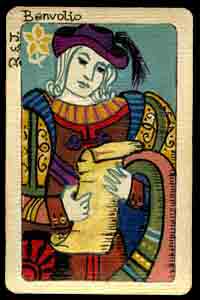If you wanted to throw a wrench into my theory about the cause of the Capulet-Montague feud in Shakespeare’s Romeo & Juliet, one needs only point out that in the earliest version, Lady Montague does not, in fact, have the final death in the play. Benvolio does.
”What?” you cry aloud. “How? Why?”
Alas, we don’t know. In the First Quarto (the ‘bad’ Quarto, the ‘eeevil’ Quarto) of R&J, printed by Thomas Crede for Cuthbert Burby in 1599, Montague announces that his wife is dead, then adds, as if in afterthought, ‘And young Benvolio is deceased as well.’ No word of how or why.
I actually like this line. Several times now I’ve contrived ways to kill Benvolio in the latter part of the play. My favorite is to have him meet a girl at the Capulet party. Later, after Juliet has drunk her potion but before she’s found, Benvolio meets this girl for an assignation. They embrace, but she recoils at once. His sword hilt is jabbing her. Sexily, she either removes his sword belt or unsheathes the weapon and lays it aside. Just then, unseen by Benvolio, the two louts from the opening scene, Gregory and Sampson, creep up. Benvolio senses them, however, and puts up a desperate fight. But he’s unarmed and is quickly killed. It’s a nice parallel to the light-hearted melee at the top of the show. Then – ah-ha! – Lady Capulet arrives to pay off her three servants, who then remove the body.
Lady Capulet? Well, she’s already told Juliet that she’s planning to send a poison to Mantua and have Romeo done in. And she blames Benvolio for spinning a web of lies around the death of Tybalt, despite the fact that he spoke true. Would she let him, ‘a kinsman to the Montague,’ live? I think not!
Whatever you do with it, the line appeals to me because it reinforces the theme: no young person makes it out of this play alive.
For more insights into Shakespeare’s play about the Star-Crossed Lovers, check out my book of essays SHAKESPEARE’S SECRETS: ROMEO & JULIET, on sale now.

An interpretation of Benvolio created by artist Hannah Tompkins.

